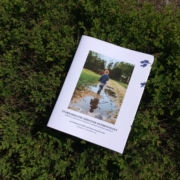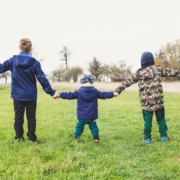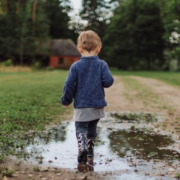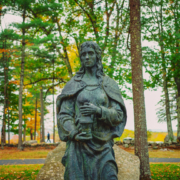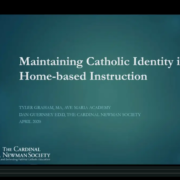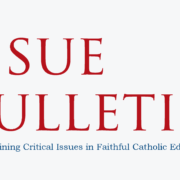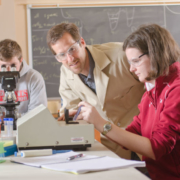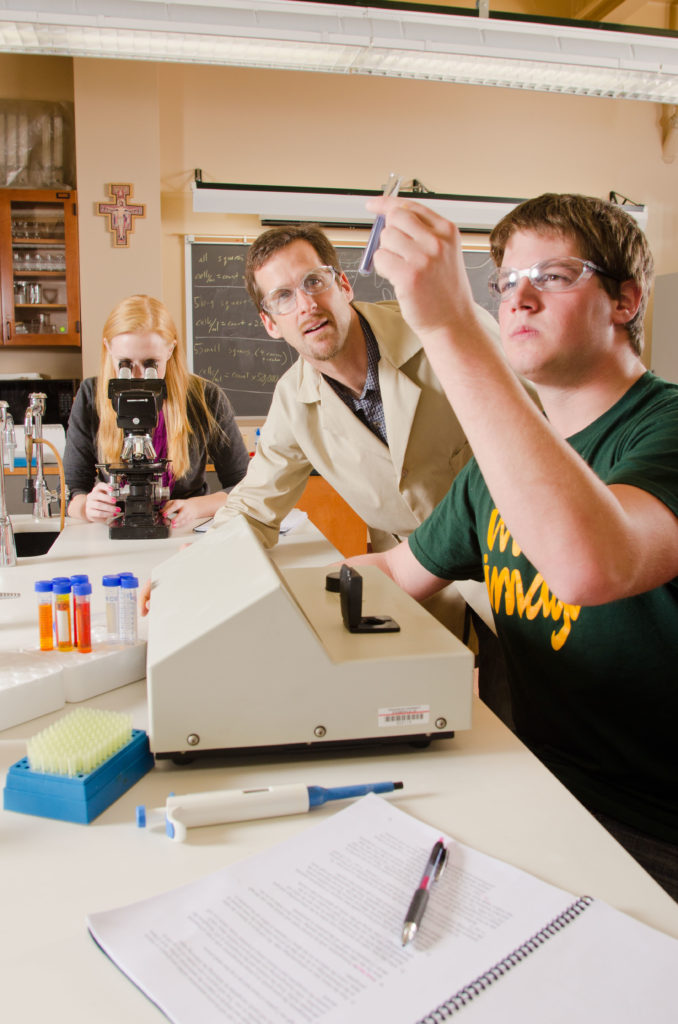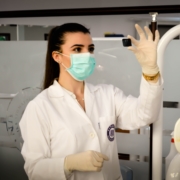A document written early in 2019 by the Congregation for Catholic Education opens by acknowledging an educational crisis in the area of affectivity and sexuality that stems from “an anthropology opposed to faith and to right reason.” It calls for: “well-structured educational programs that are coherent with the true nature of human persons (… and) a clear and convincing anthropology that gives a meaningful foundation to sexuality and affectivity.”
Just a little over 50 years ago, the future Pope John Paul II wrote to the Jesuit Cardinal Henri de Lubac about the roots of this very crisis:
“The evil of our times consists in the first place in a kind of degradation, indeed in a pulverization, of the fundamental uniqueness of each human person. (…) To this disintegration (…) we must oppose, rather than sterile polemics, a kind of “recapitulation” of the inviolable mystery of the person.”
Early in his pontificate, St. John Paul II offered what he termed an adequate anthropology through 129 talks given during Wednesday audiences that stretched from 1979-1984. These audiences were then published under the title Man and Woman He Created Them. Commonly referred to as St. John Paul II’s Theology of the Body, these teachings offer a profound vision of the dignity, goodness and worth of the human person. Created in the image of God who is a communion of persons, each person will find fulfillment and happiness, in whatever state of life, through the sincere gift-of-self.
These standards, based on St. John Paul II’s Theology of the Body teachings, provide a solid basis for incrementally transmitting (K-8) a vision of the human person according to God’s loving design. In the area of expectations, it’s important to understand that they do not address matters of sexuality through a “frontal approach”. In fact, these are not standards for teaching sexuality as such. Instead, they go deeper, to the foundations of personal identity. It’s a gamechanger for someone to be deeply convinced of their personal self-worth, dignity and purpose, knowing themself to be infinitely and unconditionally loved by God and called to live in a communion of persons in his image. This self-knowledge includes respecting and revering oneself, others and above all God. It affects the choices made by young people about how they will treat others and expect others to treat them, including in the area of sexuality. It’s a unique, theological approach to Christian anthropology that lays out the pathway to a happy, deeply fulfilled life.
Instructions for Use
Standards in a Catholic school should reflect the mission of Catholic education, to make disciples of Christ for this world and the next. These particular standards help toward the fulfillment of that mission as they focus specifically on man’s interaction with, and understanding of, God, his neighbor, and himself from a Christian perspective.
Standards are broad statements used to focus and guide curriculum. They are a foundation for an academic program from which educational objectives and learning targets are derived. They are the skeleton, so to speak, of a much broader project of educating the human person. It is through the creation of educational objectives, the choice of curricular materials and activities, and the deep and trusting relationship between all those involved in the education environment, that standards become animated and learning takes place.
Enclosed you will find Standards for Christian Anthropology: Based on St. John Paul II’s Theology of the Body Teachings. The same content has been organized in two different ways: by grade and by theme. The set of ‘standards by grade’ were designed to align with the Ruah Woods ROOTED: Theology of the Body Curriculum (K-8) and are graduated by depth of knowledge. When using the Standards in conjunction with the ROOTED curriculum students and teachers will have a specific vertical focus ensuring continuity of learning through a systematic presentation.
Some schools and dioceses might choose to re-order the standards to better integrate with their existing religion program. For that reason , we have created a ‘Standards by theme’ template with grade levels indicated within the standard numbering. Moving standards up or down a grade level is quite acceptable based upon the needs of your student population and your curricular materials as long as a developmental alignment is maintained.
When closely reviewing the scope and sequence for grades 6-8, one will find that all the major themes identified in the K-5 program are again revisited at a deeper level.

Two additional sub-themes of Vocation are also included: The Sacramentality of Marriage and Virginity for the Sake of the Kingdom. These are introduced in 8th grade. The 6th grade year has more standards than the other middle school grades to allow those schools interested in beginning a study of Christian Anthropology/Theology of the Body at the middle school level to do so without missing foundational concepts introduced in an earlier program.
When human persons know their great dignity and worth as sons and daughters of God, they are able to flourish in their Christian lives and experience profound happiness. We hope these standards will be a stepping stone for many young people to know who they are and live in accordance with their calling.
Standards for Christian Anthropology
BASED ON ST. JOHN PAUL II’S THEOLOGY OF THE BODY TEACHINGS, GRADES K-8
“God created mankind in his image; in the image of God he created them; male and female he created them.”
Genesis 1:27
Key to Numbering of Standards
Grade Level
Theme
- Creation is a Gift
- Original Solitude
- Original Unity
- Original Nakedness
- Communion of Persons
- Gift-of-self
- Body-Soul Unity
- Body Reveals the Person
- Historical Man – Fall and Redemption
- Purity of Heart/Virtue
- Vocation
- Eschatological Man – Resurrection
Number of Standard (by Theme in each Grade Level)
TOB Theology of the Body Standard
Example: K.1.1 TOB Means Kindergarten, Creation is a Gift, First standard, Theology of the Body.
NOTE: Within these Standards the term “man” refers to both “male” and “female.” References to Theology of the Body (TOB) and the Catechism of the Catholic Church (CCC) are in parentheses after each Standard.
Kindergarten
K.1.1 TOB Express that creation is a gift from God who is loving.
(TOB 13:2-3; CCC 301, 356)
K.2.1 TOB Discuss that it is unique to the human person to care for creation.
(TOB 6:4; CCC 307, 373)
K.2.2 TOB Recognize that the human person has a special relationship with God in comparison to animals.
(TOB 5-6; CCC 356, 358, 380)
K.5.1 TOB Discuss how man images the communion of God; three persons in one God.
(TOB 5-7, 9:2-9:3, 19:1; CCC 299, 343, 355-357)
K.10.1 TOB Compare the special dignity of man’s work to the activity of animals.
(cf. TOB 5:4; CCC 307, 342-343,378)
First Grade
1.1.1 TOB Express a sense of wonder for all of God’s creation.
(TOB 2-3, 13:2; CCC 299)
1.1.2 TOB Recognize the goodness of creation.
(TOB 13:3; CCC 280, 339)
1.1.3 TOB Express that every person is a gift from God.
(TOB 13:2-4, 14:4, 15, 16:3-4, 17, 18:3-19:1, 19:3; CCC 356-358, 371-372)
1.7.1 TOB Recognize that human beings manifest their inner life through their body language.
(TOB 19:4-5; CCC 2521-2524)
1.10.1 TOB Recognize that true freedom comes by choosing the good.
(TOB 13:3; CCC 1696, 1730, 1733)
1.11.1 TOB Recognize that each person is unique and unrepeatable.
(TOB 20:5; CCC 357, 366)
1.11.2 TOB Recognize that God calls us to make a gift of ourselves in love.
(TOB 46:6, 78:3; CCC 357, 1878, 2196, Gaudium et Spes 24:3)
Second Grade
2.1.1 TOB Recognize that all creatures are a sign of God’s gift in love.
(TOB 13:3; CCC 339, 342)
2.2.1 TOB Articulate how and why we are made for relationship with God (Communion).
(TOB 6:2; CCC 357-358, 374)
2.3.1 TOB Relate how we learn more about ourselves through our relationships with others.
(cf. TOB 9:4, 12:3)
2.3.2 TOB Discuss reasons why God made man male and female in Gen. 1:27 and Gen. 2:18-22a.
(cf. TOB 2-3; 13:2; CCC 371-372)
2.5.1 TOB Discuss how we are created in the image and likeness of the Trinitarian God.
(TOB 9:2 – 9:3, 13:2, 19:1; CCC 355-357)
2.6.1 TOB Express that man is called to give himself through love as “Gift.”
(TOB 15:1; CCC 357, 1878, 2196; Gaudium et Spes 24:3)
2.6.2 TOB Discuss how Jesus is the model of what it means for a person to be a gift.
(TOB 90:5-6; CCC 519-520)
2.7.1 TOB Discuss how the character of a person is embodied in their comportment.
(cf. 1Cor. 6:19-20, 1Thess. 4:4, TOB 57:1-3; CCC 2521-2524)
2.8.1 TOB Analyze how the body reveals that each person is made for relationship with God, others, and the world.
(TOB 12:1, 13:4; CCC 340, 344, 371-373)
Third Grade
3.2.1 TOB Give examples of man’s unique relationship with God as set apart from the rest of creation: naming the animals, cultivating the earth, and choosing between good and evil.
(TOB 5:4, 6; CCC 343, 356, 373, 378)
3.6.1 TOB Contrast how God can enable people to view the world and others as gifts with how some people view the world and others as a threat, eliciting a response of selfishness and manipulation.
(cf. TOB 15:1, 46:6; CCC 2514, 2517-2519, 2524, 2531)
3.8.1 TOB Relate how the body reveals the person.
(TOB 14:4; CCC 364-366, 371)
3.9.1 TOB Relate man’s relationship with God in original solitude to the restoration of man’s relationship with God through baptism.
(cf. TOB 91:5, 92:2, 96:2-5; CCC 374, 1265, 1272-1273)
3.10.1 TOB Relate being connected to Jesus the True Vine (Jn 15:4-5) to manifesting the fruits of the Spirit (Gal 5:22-23).
(cf. TOB 51; CCC 736, 1831-1832, 2074)
3.12.1 TOB Recognize that in heaven there will be a profound unity and harmony between the soul and the body.
(TOB 66:5-6; CCC 996-997)
Fourth Grade
4.3.1 TOB Interpret the significance of Genesis 2:18: “It is not good for man to be alone. I will make a helper fit for him.”
(TOB 9:2; CCC 371-372)
4.3.2 TOB Compare Adam’s joy at the creation of Eve to his response to the creation of the animals.
(TOB 10:1; CCC 371)
4.5.1 TOB Extrapolate how man is created in God’s image through the communion of persons.
(TOB 9:3, 14:6; CCC 355-357)
4.7.1 TOB Connect how virtues (which have to do with man’s inner life) are expressed through the body.
(TOB 51:5-6, 53:4, 54:2-55:7; CCC 2516, 2520-2524)
4.9.1 TOB Recognize that suffering is a result of the Fall and that suffering can make it difficult for us to see the gifts of God.
(cf. TOB 26:4-5, 27:1-2; CCC 385, 400, 402, 404-405)
4.9.2 TOB Relate how Christ nourishes communion through the gift of himself in the Eucharist.
(TOB 99:1; CCC 1391, 1392)
4.11.1 TOB Demonstrate how through our work we make a gift of ourselves.
(cf. TOB 6:4, 7:2; CCC 2427-2428)
4.11.2 TOB Relate how work helps us fulfill a mission.
(cf. TOB 6:4, 7:2; CCC 373, 2427-2428)
4.12.1 TOB Discuss how at the Resurrection we will experience the most perfect communion with God and others.
(TOB 68:1-4; CCC 1023-1025)
4.12.2 TOB Identify ways where God is, or was, present in their own life.
(cf. TOB 65:5; CCC 356-357, 22ff)
Fifth Grade
5.1.1 TOB Compare and contrast ancient myths of creation to Sacred Scripture and God’s goodness in creating.
(cf. TOB 13:2-4; CCC 285, 287-301)
5.4.1 TOB Explain how original nakedness refers to seeing the world and others as God sees; as Gift.
(TOB 13, 14:2; CCC 337, 339, 377, 2531)
5.6.1 TOB Demonstrate that man comes to know himself through a gift-of-self.
(TOB 22:4; CCC 357; Gaudium et Spes 24:3)
5.9.1 TOB Recognize that Jesus reveals the love of the Father.
(TOB 23:4, 67:5; CCC 606-607; 1823)
5.10.1 TOB Articulate how virtue is part of ‘life according to the Spirit.’
(cf. Eph. 6:13-17) (cf. TOB 51:5-6; CCC 736, 1824, 1830, 1839-1841, 2514-2519)
5.12.1 TOB Discuss how at the Resurrection we will see as God sees and our bodies will perfectly reveal his love.
(TOB 68.1, 69:6; CCC 997, 1003, 1011, 1023, 1026, 1028)
Sixth Grade
6.1.1 TOB Exhibit wonder and awe at the generosity of God in the gifts of His abundant and beautiful creation.
(TOB 2-3, 13:2; CCC 293-295, 341)
6.1.2 TOB Explain how creation is a good gift created from nothing.
(TOB 13:4; CCC 296-298)
6.2.1 TOB Define “original experience” as the most basic human experiences all humanity has in common: original solitude, original unity, original nakedness.
(TOB 4:4, 11:1)
6.2.2 TOB Explain how original solitude means the experience of man’s being alone-with-God; his unique relationship to God.
(TOB 6:2; CCC 374-375)
6.2.3 TOB Differentiate how man, as the pinnacle of creation, is both similar and dissimilar from God.
(TOB 6-7, 9:2-3; CCC 339-344, 355-358)
6.3.1 TOB Define “original unity” as the experience of man’s unity-in-difference; the unique relation between male and female.
(TOB 9:1; CCC 369-373)
6.3.2 TOB Identify the two ways of being human, male and female.
(TOB 8:1, 10:1; CCC 369-372)
6.3.3 TOB Discuss why it is a good thing that God created man as male and female.
(TOB 9:3, 13:3, 14:1, 16:1-2; CCC 371-372)
6.4.1 TOB Define “original nakedness” as experiencing the true and clear vision of the person; as gift and in God’s image.
(TOB 13:1; CCC 337, 339, 377)
6.4.2 TOB Exhibit the virtue of reverence for God, his creation, and other people by treating them with respect and honor, for God is all good and his creation is a good gift.
(TOB 14:4, 15:4, 119-120, 132:1; CCC 2096-2097, 2415-2418, 2479)
6.5.1 TOB Explain how man, in the image of the Trinity, learns about himself through a gift of himself.
(TOB 8:4, 9:1-3, 10:1, 15:1; CCC 355-357,1889; Gaudium et Spes 24:3)
6.6.1 TOB Explain gift-of-self as thoughts, words or actions that place oneself at the service of others and seek the true good of the other.
(cf. TOB 14:2; CCC 1609, 1667, 1889, 1914, 1926)
6.7.1 TOB Describe how the body-soul unity reveals man’s special dignity.
(TOB 18:4, 19:3-5, 23:5, 56-57:3; CCC 2518, 2520-2524)
6.8.1 TOB Explain how the human body is a visible sign (a “sacrament”) of God’s invisible love.
(TOB 19:4; CCC 355-356, 364)
6.8.2 TOB Describe how the human body is the “temple of the Holy Spirit” (1Cor 6:15) and why it is necessary to “glorify God in your body” (1Cor 6:20).
(TOB 57:2; CCC 2516, 2519)
Seventh Grade
7.1.1 TOB Explain that even after the Fall, creation remains a good gift and is not totally corrupted; it is able to be redeemed.
(cf. TOB 32:3, 86; CCC 410-412, 422, 1045-1048)
7.1.2 TOB Provide examples of rightly ordered desire, given by God, and disordered “desire.”
(TOB 48:4; CCC 374-379, 400, 2514-2516, 2517-2520, 2528-2531, 2541, 2543-2544, 2546, 2548-2549, 2555, 2557)
7.5.1 TOB Propose how a “communion of persons” involves the loving gift-of-self (i.e. the Trinity, but also the unity of the Church, the family and the unity of man and woman).
(cf. TOB 8:4, 9:1-3, 10:1, 15:1; CCC 813, 1644 – 1647, 2205)
7.6.1 TOB Evaluate actions for self-mastery and describe how actions of self-mastery free one to make a full gift-of-self.
(TOB 15:1-4, 32:6; CCC 2339, 2340, 2343, 2346)
7.7.1 TOB Explain the body-soul unity in the human person from the standpoint of the “language of the Body.”
(TOB 9:4, 10:1, 14:6, 15, 16:1-2, 23:4-5, 123:4-5, 125: 1-2, 127:4; CCC 2518, 2521-2524)
7.8.1 TOB Describe how the body, by its mere existence, communicates that the human person is a gift just by the fact that it exists.
(TOB 14:4; CCC 357, 364)
7.9.1 TOB Point out that as a result of original sin man experiences concupiscence and needs to bring emotions and desires into harmony with what is truly good.
(TOB 26:5, 31:3, 31:6, 32:3, 33:1-2, 51:5-6, 54; CCC 397, 400, 405, 1707, 1865, 1949, 2514-2520, 2534-2535, 2549)
7.10.1 TOB Explain how Christ does not accuse but instead appeals to the human heart to be pure.
(TOB 45:5, 46:5-6, 49:7; CCC 2517-2519)
7.10.2 TOB Describe what ‘life according to the Spirit’ is and how following the law of God leads to true freedom and happiness.
(TOB 15:1, 45:1, 51:5-6, 53:4-5, 54:2-4; CCC 30, 736, 1731, 1824, 1828-1832, 2514-2516, 2548)
7.11.1 TOB Evaluate how love, as a power, is a participation in the love of God himself: How it is total. How it is faithful. How it is fruitful. How it is generous.
(TOB 127:1; CCC 2331, 2335, 2360, 2364-2369)
Eighth Grade
8.1.1 TOB Propose that creation should be received as a gift and not manipulated, dominated and controlled.
(cf. TOB 13:3-4, 59:3; CCC 358, 373)
8.5.1 TOB Compare how the loving communion of man and woman is like that of the Trinity, a communion of persons who are love and who in giving and receiving are fruitful.
(TOB 9:1-3, 10:4, 14:6, 15:1; CCC 355-357)
8.6.1 TOB Give examples of how a person is pure in heart, that is, when he/she perceives and respects others as a gift and seeks to make a gift of him/herself to others.
(TOB 50, 54, 57:3; CCC 2518, 2519)
8.8.1 TOB Explain that living out the spousal meaning of the body can be through marriage or virginity for the sake of the Kingdom.
(TOB 15:5, 81:6; CCC 915, 916, 922, 923, 926, 1640, 1646)
8.10.1 TOB Evaluate the beatitude: “Blessed are the pure in heart, because they will see God.”
(cf. Mt.5:8 and TOB 43:5; CCC 2518, 2519, 2530-2533)
8.11.1 TOB Describe the idea of a vocation and how it is the way one makes a total gift-of-self.
(TOB 78, 86; CCC 915-916, 929, 932, 1579, 1603, 1605, 1618-1620)
8.11.2 TOB Compare and contrast the sacrament of marriage and celibacy for the sake of the kingdom.
(TOB 76:6, 78:4; CCC 915, 916, 1603, 1618-1620, 1621)
8.11.3 TOB Explain how God invites, and does not force, when he calls someone to the vocation of married life, consecrated life, or the priesthood, leaving the person free to respond.
(TOB 73:3-4, 76:4, 79:8; CCC 915, 1565, 1578, 1599, 1618, 1625-1628, 2233)
8.11.4 TOB Describe how responding to the call of the consecrated life is a radical imitation of the life of Christ and is done to work for the kingdom of God on earth.
(TOB 75:1, 75:4, 76:3, 79:2, 79:9, 81:4; CCC 915-916, 929, 932, 1579, 1618)
8.11.5 TOB Explain that when God calls a man and a woman to the vocation of marriage, he is inviting them into a special sacrament of his love.
(Ephesians 5 and TOB 87-93; CCC 1601, 1604)
8.12.1 TOB Explain what will happen to the body at the Resurrection.
(cf. TOB 64-72; CCC 997-1001)
Standards for Christian Anthropology
Based on St. John Paul II’s Theology of the Body Teachings
Scope and Sequence
Grades K-8

Standards for Christian Anthropology by Theme
Based on St. John Paul II’s Theology of the Body Teachings
NOTE: Within these Standards the term “man” refers to both “male” and “female.” References to Theology of the Body (TOB) and the Catechism of the Catholic Church (CCC) are in parentheses after each Standard.
1. Creation is a Gift
K.1.1 TOB Express that creation is a gift from God who is loving.
(TOB 13:2-3; CCC 301, 356)
1.1.1 TOB Express a sense of wonder for all of God’s creation.
(TOB 2-3, 13:2; CCC 299)
1.1.2 TOB Recognize the goodness of creation.
(TOB 13:3; CCC 280, 339)
1.1.3 TOB Express that every person is a gift from God.
(TOB 13:2-4, 14:4, 15, 16:3-4, 17, 18:3-19:1, 19:3; CCC 356-358, 371-372)
2.1.1 TOB Recognize that all creatures are a sign of God’s gift in love.
(TOB 13:3; CCC 339, 342)
5.1.1 TOB Compare and contrast ancient myths of creation to Sacred Scripture and God’s goodness in creating.
(cf. TOB 13:2-4; CCC 285, 287-301)
6.1.1 TOB Exhibit wonder and awe at the generosity of God in the gifts of His abundant and beautiful creation.
(TOB 2-3, 13:2; CCC 293-295, 341)
6.1.2 TOB Explain how creation is a good gift created from nothing.
(TOB 13:4; CCC 296-298)
7.1.1 TOB Explain that even after the Fall, creation remains a good gift and is not totally corrupted; it is able to be redeemed.
(cf. TOB 32:3, 86; CCC 410-412, 422, 1045-1048)
7.1.2 TOB Provide examples of rightly ordered desire, given by God, and disordered “desire.”
(TOB 48:4; CCC 374-379, 400, 2514-2516, 2517-2520, 2528-2531, 2541, 2543-2544, 2546, 2548-2549, 2555, 2557)
8.1.1 TOB Propose that creation should be received as a gift and not manipulated, dominated and controlled.
(cf. TOB 13:3-4, 59:3; CCC 358, 373)
2. Original Solitude
K.2.1 TOB Discuss that it is unique to the human person to care for creation.
(TOB 6:4; CCC 307, 373)
K.2.2 TOB Recognize that the human person has a special relationship with God in comparison to animals.
(TOB 5-6; CCC 356, 358, 380)
2.2.1 TOB Articulate how and why we are made for relationship with God (Communion).
(TOB 6:2; CCC 357-358, 374)
3.2.1 TOB Give examples of man’s unique relationship with God as set apart from the rest of creation: naming the animals, cultivating the earth, and choosing between good and evil.
(TOB 5:4, 6; CCC 343, 356, 373, 378)
6.2.1 TOB Define “original experience” as the most basic human experiences all humanity has in common: original solitude, original unity, original nakedness.
(TOB 4:4, 11:1)
6.2.2 TOB Explain how original solitude means the experience of man’s being alone-with-God; his unique relationship to God.
(TOB 6:2; CCC 374-375)
6.2.3 TOB Differentiate how man, as the pinnacle of creation, is both similar and dissimilar from God.
(TOB 6-7, 9:2-3; CCC 339-344, 355-358)
3. Original Unity
2.3.1 TOB Relate how we learn more about ourselves through our relationships with others.
(cf. TOB 9:4, 12:3)
2.3.2 TOB Discuss reasons why God made man male and female in Gen. 1:27 and Gen. 2:18-22a.
(cf. TOB 2-3; 13:2; CCC 371-372)
4.3.1 TOB Interpret the significance of Genesis 2:18: “It is not good for man to be alone. I will make a helper fit for him.”
(TOB 9:2; CCC 371-372)
4.3.2 TOB Compare Adam’s joy at the creation of Eve to his response to the creation of the animals.
(TOB 10:1; CCC 371)
6.3.1 TOB Define “original unity” as the experience of man’s unity-in-difference; the unique relation between male and female.
(TOB 9:1; CCC 369-373)
6.3.2 TOB Identify the two ways of being human, male and female.
(TOB 8:1, 10:1; CCC 369-372)
6.3.3 TOB Discuss why it is a good thing that God created man as male and female.
(TOB 9:3, 13:3, 14:1, 16:1-2; CCC 371-372)
4. Original Nakedness
5.4.1 TOB Explain how original nakedness refers to seeing the world and others as God sees; as Gift.
(TOB 13, 14:2; CCC 337, 339, 377, 2531)
6.4.1 TOB Define “original nakedness” as experiencing the true and clear vision of the person; as gift and in God’s image.
(TOB 13:1; CCC 337, 339, 377)
6.4.2 TOB Exhibit the virtue of reverence for God, his creation, and other people by treating them with respect and honor, for God is all good and his creation is a good gift.
(TOB 14:4, 15:4, 119-120, 132:1; CCC 2096-2097, 2415-2418, 2479)
5. Communion of Persons
K.5.1 TOB Explain that the human person is made in the image and likeness of God who is one God in three persons.
(TOB 5-7, 9:2-9:3, 19:1; CCC 299, 343, 355-357)
2.5.1 TOB Discuss how we are created in the image and likeness of the Trinitarian God.
(TOB 9:2 – 9:3, 13:2, 19:1; CCC 355-357)
4.5.1 TOB Extrapolate how man is created in God’s image through the communion of persons.
(TOB 9:3, 14:6; CCC 355-357)
6.5.1 TOB Explain how man, in the image of the Trinity, learns about himself through a gift of himself.
(TOB 8:4, 9:1-3, 10:1, 15:1; CCC 355-357,1889; Gaudium et Spes 24:3)
7.5.1 TOB Propose how a “communion of persons” involves the loving gift-of-self (i.e. the Trinity, but also the unity of the Church, the family and the unity of man and woman).
(cf. TOB 8:4, 9:1-3, 10:1, 15:1; CCC 813, 1644-1647, 2205)
8.5.1 TOB Compare how the loving communion of man and woman is like that of the Trinity, a communion of persons who are love and who in giving and receiving are fruitful.
(TOB 9:1-3, 10:4, 14:6; 15:1; CCC 355-357)
6. Gift-of-Self
2.6.1 TOB Express that man is called to give himself through love as “Gift.”
(TOB 15:1; CCC 357, 1878, 2196; Gaudium et Spes 24:3)
2.6.2 TOB Discuss how Jesus is the model of what it means for a person to be a gift.
(TOB 90:5-6; CCC 519-520)
3.6.1 TOB Contrast how God can enable people to view the world and others as gifts with how some people view the world and others as a threat, eliciting a response of selfishness and manipulation.
(cf. TOB 15:1, 46:6; CCC 2514, 2517-2519, 2524, 2531)
5.6.1 TOB Demonstrate that man comes to know himself through a gift-of-self.
(TOB 22:4; CCC 357; Gaudium et Spes 24:3)
6.6.1 TOB Explain gift-of-self as thoughts, words or actions that place oneself at the service of others and seek the true good of the other.
(cf. TOB 14:2; CCC 1609, 1667, 1889, 1914, 1926)
7.6.1 TOB Evaluate actions for self-mastery and describe how actions of self-mastery free one to make a full gift-of-self.
(TOB 15:1-4, 32:6; CCC 2339, 2340, 2342, 2346)
8.6.1 TOB Give examples of how a person is pure in heart, that is, when he/she perceives and respects others as a gift and seeks to make a gift of him/herself to others.
(TOB 50, 54, 57:3; CCC 2518, 2519)
7. Body-soul Unity
1.7.1 TOB Recognize that human beings manifest their inner life through their body language.
(TOB 19:4-5; CCC 2521 – 2524)
2.7.1 TOB Discuss how the character of a person is embodied in their comportment.
(cf. 1Cor. 6:19-20, 1Thess. 4:4, TOB 57:1-3; CCC 2521-2524)
4.7.1 TOB Connect how virtues (which have to do with man’s inner life) are expressed through the body.
(TOB 51:5-6, 53:4, 54:2-55:7; CCC 2516, 2520-2524)
6.7.1 TOB Describe how the body-soul unity reveals man’s special dignity.
(TOB 18:4, 19:3-5, 23:5, 56-57:3; CCC 2518, 2520-2524)
7.7.1 TOB Explain the body-soul unity in the human person from the standpoint of the “language of the Body.”
(TOB 9:4, 10:1, 14:6, 15, 16:1-2, 23:4-5, 123:4-5, 125: 1-2, 127:4; CCC 2518, 2521-2524)
8. Body Reveals the Person
2.8.1 TOB Analyze how the body reveals that each person is made for relationship with God, others, and the world.
(TOB 12:1, 13:4; CCC 340, 344, 371-373)
3.8.1 TOB Relate how the body reveals the person.
(TOB 14:4; CCC 364-366, 371)
6.8.1 TOB Explain how the human body is a visible sign (a “sacrament”) of God’s invisible love.
(TOB 19:4; CCC 355-356, 364)
6.8.2 TOB Describe how the human body is the “temple of the Holy Spirit” (1Cor 6:15) and why it is necessary to “glorify God in your body” (1Cor 6:20).
(TOB 57.2; CCC 2516, 2519)
7.8.1 TOB Explain how the body, by its mere existence, communicates that the human person is a gift just by the fact that it exists.
(TOB 14:4; CCC 357, 364)
8.8.1 TOB Explain that living out the spousal meaning of the body can be through marriage or virginity for the sake of the Kingdom.
(TOB 15:5, 81:6; CCC 915, 916, 922, 923, 926, 1640, 1646)
9. Historical Man/Fall and Redemption
3.9.1 TOB Relate man’s relationship with God in original solitude to the restoration of man’s relationship with God through baptism.
(cf. TOB 91:5, 92:2, 96:2-5; CCC 374, 1265, 1272-1273)
4.9.1 TOB Recognize that suffering is a result of the Fall and that suffering can make it difficult for us to see the gifts of God.
(cf. TOB 26:4-5, 27:1-2; CCC 385, 400, 402, 404-405)
4.9.2 TOB Relate how Christ nourishes communion through the gift of himself in the Eucharist.
(TOB 99:1; CCC 1391, 1392)
5.9.1 TOB Recognize that Jesus reveals the love of the Father.
(TOB 23:4, 67:5; CCC 606-607; 1823)
7.9.1 TOB Point out that as a result of original sin man experiences concupiscence and needs to bring emotions and desires into harmony with what is truly good.
(TOB 26:5, 31:3, 31:6, 32:3, 33:1-2, 51:5-6, 54; CCC 397, 400, 405, 1707, 1865, 1949, 2514-2520, 2534-2535, 2549)
10. Purity of Heart/Virtue
K.10.1 TOB Compare the special dignity of man’s work to the activity of animals.
(cf. TOB 5:4; CCC 307, 342-343,378)
1.10.1 TOB Recognize that true freedom comes by choosing the good.
(TOB 13:3; CCC 1696, 1730, 1733)
3.10.1 TOB Relate being connected to Jesus the True Vine (Jn 15:4-5) to manifesting the fruits of the Spirit (Gal 5:22-23).
(cf. TOB 51; CCC 736, 1831-1832, 2074)
4.10.1 TOB Discuss how the body expresses virtue.
(cf. TOB 57:1-3; CCC 1803-1804)
5.10.1 TOB Articulate how virtue is part of ‘life according to the Spirit’ (cf. Eph. 6:13-17).
(cf. TOB 51:5-6; CCC 736, 1824, 1830, 1839-1841, 2514-2519)
7.10.1 TOB Explain how Christ does not accuse but instead appeals to the human heart to be pure.
(TOB 45:5, 46:5-6, 49:7; CCC 2517-2519)
7.10.2 TOB Describe what ‘life according to the Spirit’ is and how following the law of God leads to true freedom and happiness.
(TOB 15:1, 45:1, 51:5-6, 53:4-5, 54:2-4; CCC 30, 736, 1731, 1824, 1828-1832, 2514-2516, 2548)
8.10.1 TOB Evaluate the beatitude: “Blessed are the pure in heart, because they will see God”(cf. Mt.5:8).
(TOB 43:5; CCC 2518, 2519, 2530-2533)
11. Vocation
1.11.1 TOB Recognize that each person is unique and unrepeatable.
(TOB 20:5; CCC 357, 366)
1.11.2 TOB Recognize that God calls us to make a gift of ourselves in love.
(TOB 46:6, 78:3; CCC 357, 1878, 2196, Gaudium et Spes 24:3)
4.11.1 TOB Demonstrate how through our work we make a gift of ourselves.
(cf. TOB 6:4, 7:2; CCC 2427-2428)
4.11.2 TOB Relate how work helps us fulfill a mission.
(cf. TOB 6:4, 7:2; CCC 373, 2427-2428)
7.11.1 TOB Evaluate how love, as a power, is a participation in the love of God himself: How it is total. How it is faithful. How it is fruitful. How it is generous.
(TOB 127:1; CCC 2331, 2335, 2360, 2364-2369)
8.11.1 TOB Describe the idea of a vocation and how it is the way one makes a total gift-of-self.
(TOB 78, 86; CCC 915-916, 929, 932, 1579, 1603, 1605, 1618-1620)
8.11.2 TOB Compare and contrast the sacrament of marriage and celibacy for the sake of the kingdom.
(TOB 76:6, 78:4; CCC 915, 916, 1603, 1618-1620, 1621)
8.11.3 TOB Explain how God invites, and does not force, when he calls someone to the vocation of married life, consecrated life, or the priesthood, leaving the person free to respond.
(TOB 73:3-4; 76:4; 79:8; CCC 915, 1565, 1578, 1599, 1618, 1625-1628, 2233)
Vocation: Virginity for the Sake of the Kingdom
8.11.4 TOB Describe how responding to the call of the consecrated life is a radical imitation of the life of Christ and is done to work for the kingdom of God on earth.
(TOB 75:1, 75:4, 76:3, 79:2, 79:9, 81:4; CCC 915-916, 929, 932, 1579, 1618)
Vocation: Sacramentality of Marriage
8.11.5 TOB Explain that when God calls two people to the vocation of marriage, he is inviting them into a special sacrament of his love.
(Ephesians 5 and TOB 87-93; CCC 1601, 1604)
12. Eschatological Man/Resurrection
3.12.1 TOB Recognize that in heaven there will be a profound unity and harmony between the soul and the body.
(TOB 66:5-6; CCC 996-997)
4.12.1 TOB Discuss how at the Resurrection we will experience the most perfect communion with God and others.
(TOB 68:1-4; CCC 1023-1025)
4.12.2 TOB Identify ways where God is, or was, present in their own life.
(cf. TOB 65:5; CCC 356-357, 22ff)
5.12.1 TOB Discuss how at the Resurrection we will see as God sees and our bodies will perfectly reveal his love.
(TOB 68.1, 69:6; CCC 997, 1003, 1011, 1023, 1026, 1028)
8.12.1 TOB Explain what will happen to the body at the Resurrection.
(cf. TOB 64-72; CCC 997-1001)
Glossary
Body–Soul Unity “The unity of soul and body is so profound that one has to consider the soul to be the ‘form’ of the body: i.e., it is because of its spiritual soul that the body made of matter becomes a living human body; spirit and matter, man, are not two natures united, but rather their union forms a single nature.” CCC 365.
Communion of Persons a deep union/unity with another which exists through a sincere and mutual gift-of-self. More than a simple interaction with something or someone.
Concupiscence the inclination toward things that aren’t good for us; it is a consequence of original sin and a permanent wound in our nature. It is not a sin in itself.
Eschatological Man the human person at the end of time in heaven, after Jesus returns for the final judgment and the dead receive their bodies back for eternal life in heaven or eternal condemnation in hell.
Gift-of-Self thoughts, words or actions that place oneself at the service of others and which seek the true good of the other.
Historical Man the human person in his fallen condition after original sin (everyone after Adam and Eve, except for Jesus Christ and Mary).
Language of the Body the way in which the body speaks without words. Even before you do something, your body already communicates that you are a gift (from, with, and for others) just by the fact that it exists.
Man the human person (adam – pronounced a dom in Hebrew) considered as a human being (both male and female). In the creation account of Genesis, the Bible distinguishes the first human being, ‘man’ (adam), as ‘male’ ‘ish’ (pronounced eesh) and ‘female’, ‘isha’ (pronounced eesha)
Original Experiences the most basic human experiences all humanity has in common: original solitude, original unity, original nakedness (See below).
Original Man a way of talking about the state of man before Original Sin.
Original Nakedness the experience of “seeing” the true and clear vision of the person; it is the experience of seeing the person as God sees them in the deepest truths of who they really are as unquestionable signs of the image of God in man.
Original Solitude the experience of man being alone with God. The fact that there is no other like him; Man is different from the animals, from plants and all created things. This difference is exhibited in his physical body, in his intellect (self-consciousness), in his will (self-determination).
Original Unity the experience of man’s unity-in-difference; the unique relation between male and female. Men and women share the same nature and the same dignity as being made in the image and likeness of God; they are embodied souls, yet they are different in their physical bodies which together form a complete picture of what it means to be human.
Purity of Heart is the right ordering of desires which allows us to love what is truly good; to treat God, ourselves, and others with reverence. It is an attitude, an ability, a virtue that has its source in the heart and is expressed in action.
Spousal Meaning of the Body the body expresses the fact that my life is a gift and that I am called to make a gift-of-self. This is the deepest meaning of my life and what is most basically true about being a human, male and female, created in the image of God.
Threefold Concupiscence John Paul II cites 1 John 2:16-17 in speaking of the threefold form of “the concupiscence of the flesh, the concupiscence of the eyes, and the pride of life” (TOB 26:1). These have to do with our disordered desires for pleasure, possessions, and power.
Virginity for the Sake of the Kingdom/Celibacy for the Sake of the Kingdom interchangeable terms used in John Paul IIs Theology of the Body for choosing to reserve one’s sexual powers in imitation of Christ and as a sign of the future kingdom so as to be totally at the service of whatever mission God calls them to on earth. This way of life involves renunciation and sacrifice for higher goods and the exclusive gift-of-self for the kingdom of God in heaven.
Professional Reviewers
We gratefully acknowledge the following Catholic educators, academics, and catechists whose reviews and comments contributed significantly to the development of these Standards:
Jill Annable
Assistant Superintendent for Curriculum, Instruction and Technology
Diocese of Grand Rapids, MI
Timothy Carpenter, MA
Director of Religious Education
Diocese of Lansing, MI
David Crawford, JD, STD
Assoc. Dean, Pontifical John Paul II Institute for the Studies on Marriage and Family
The Catholic University of America
Mary Ann Draudt
Assistant Superintendent Curriculum & Technology Integration
Diocese of Joliet, IL
Steven Greene, MA
Director, Kino Catechetical Institute
Archdiocese of Phoenix, AZ
David C. Hajduk, PhD
High School Religion Teacher, TOB Author
Diocese of Paterson, NJ
Keith Houde, PhD
Professor of Psychology and Chair of the Department of Psychology
Ave Maria University
David McCutchen, MA
Director Religious Education
Diocese of Toledo, OH
Elena Orozco, EdD
Assistant Director
RC Education
Fr. John Riccardo, STL
Acts XXIX Ministry
Archdiocese of Detroit, MI
Jim Rigg, PhD
Superintendent of Schools
Archdiocese of Chicago, IL
David L. Schindler, PhD
Professor of Metaphysics and Anthropology, Pontifical John Paul II Institute for the Studies on Marriage and Family
The Catholic University of America
Meghan Schofield, PhD Candidate
Pontifical John Paul II Institute for the Studies on Marriage and Family
ROOTED: Theology of the Body, Grade 6-8 Author
Michael Waldstein, PhD
Professor of Theology
Franciscan University Steubenville
Deacon Paul Ward, MA, MS
Superintendent of Schools and Director of Religious Education
Diocese of Steubenville, OH
George Weigel, MA
Senior Fellow, Ethics & Public Policy Center Washington DC
Petroc Willey, STL, PhD
Professor of Catechesis
Franciscan University Steubenville
Fr. Thomas Wray, MDiv
Parish Priest, Archdiocese of Cincinnati
Chaplain and Curriculum Consultant
Ruah Woods Press
Katrina J. Zeno, MTS
Theology of the Body
Author, Speaker, and Teacher Trainer
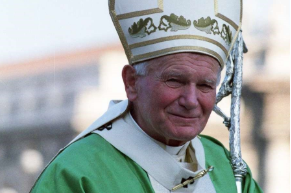
And, of course, Pope St. John Paul II,
for starting it all.


